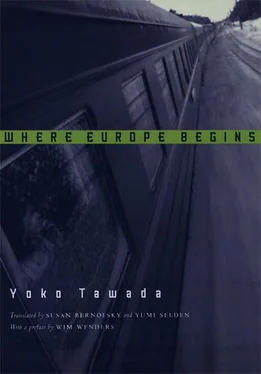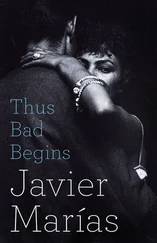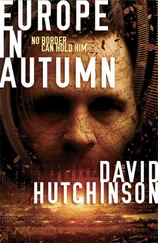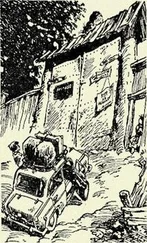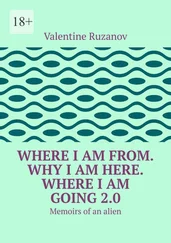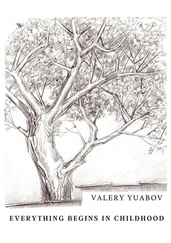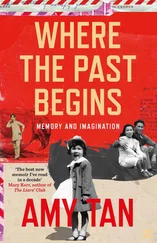“We won’t be able to meet any more, will we,” Kinoko-san is singing far off, in the strange voice of a crow at sunset, but when in a panic I clutch at the window and pull myself up to look out, the trees that look like telephone poles are already gone.
In any city one finds a surprisingly large number of people who cannot read. Some of them are still too young, others simply refuse to learn the letters of the alphabet. There are also a good many tourists and workers from other countries who live with a different set of characters altogether. In their eyes, the image of the city seems enigmatic, veiled.
I already knew the alphabet when I arrived in Hamburg, but I could gaze at the individual letters for a long time without recognizing the meaning of the words. For example, every day I looked at the same posters beside the bus stop but never read the names of the products. I know only that on one of the most beautiful of these posters the letter S appeared seven times. I don’t think this letter reminded me of the shape of a snake. Not only the S, but all the other letters as well differed from live snakes in that they lacked both moisture and flesh. I repeated the S sounds in my mouth and noticed that my tongue suddenly tasted odd. I hadn’t known a tongue, too, could taste of something.
The woman I met at this bus stop had a name that began with S: Sasha. I knew at once she couldn’t read. Whenever she saw me she gazed at me intently and with interest, but she never attempted to read anything in my face. In those days I often found that people became uneasy when they couldn’t read my face like a text.
It’s curious the way the expression of a foreigner’s face is often compared to a mask. Does this comparison conceal a wish to discover a familiar face behind the strange one?
Sasha complacently accepted all forms of illegibility. She didn’t want to “read” things, she wanted to observe them, in detail. She must have been in her mid-fifties. I don’t remember what color her hair was. I didn’t learn to register hair-colors as a child, and so I still can’t do this. Sasha often waited at the bus stop to meet her girlfriend. For Sonia — that’s what she called her friend — was unable to get out of the bus on her own. Her arms and legs were incapable of working in unison toward a single goal, they couldn’t all follow the same directions at once.
Sasha pressed Sonia’s arms and legs together and called her name a few times, as though the name could bring harmony to her limbs.
Sasha and Sonia shared an apartment. Three times a week someone came to attend to whatever written business there was. Apart from reading and writing, the two of them were able to manage everything they needed to live their lives.
A few times they had me over for coffee. There were questions Sasha and Sonia never asked, though I encountered these questions everywhere I went: mostly they began, “Is it true that the Japanese….” That is, most people wanted to know whether or not something they’d read in a newspaper or magazine was true. I was also often asked questions beginning, “In Japan do people also….” I was never able to answer them. Every attempt I made to describe the difference between two cultures failed: this difference was painted on my skin like a foreign script which I could feel but not read. Every foreign sound, every foreign glance, every foreign taste struck my body as disagreeable until my body changed. The Ö sounds, for example, stabbed too deeply into my ears and the R sounds scratched my throat. Certain expressions even gave me goose flesh, for instance “to get on his nerves,” “fed up to here” or “all washed up.”
Most of the words that came out of my mouth had nothing to do with how I felt. But at the same time I realized that my native tongue didn’t have words for how I felt either. It’s just that this never occurred to me until I’d begun to live in a foreign language.
Often it sickened me to hear people speak their native tongues fluently. It was as if they were unable to think and feel anything but what their language so readily served up to them.
From our bus stop one could see not only the various billboards but also the signs for a few restaurants. One of them belonged to a Chinese restaurant called “The Golden Dragon.” Two Chinese characters shone gold and green. The first character meant “gold,” and the second “dragon,” I explained once to Sasha as I saw her staring at this sign. Sasha then pointed out that the second character was even shaped something like a “real” dragon. And in fact it is possible to see the image of a dragon in this character: the little box in the upper right-hand corner might be a dragon's head, and the lines on the right side remind me of a dragon’s back. But Sasha knew it wasn’t a “picture” of the dragon — she asked me whether I, too, could write it.
A few weeks later Sasha showed me a teacup and said that she’d discovered the “dragon” symbol on it. Indeed, the cup did bear this sign. Sasha had seen it in a shop and immediately bought it. For the first time in her life, she could read. Then I wanted to teach her some more characters. She’ll always be illiterate, since she can’t read the letters of the alphabet, but now she can read one character and knows that the alphabet isn’t the only system of writing in the world.
Next to the bus stop was a small shop in which Sasha sometimes bought Sonia a bar of soap. Sonia loves soap, or, rather, she loves the packaging it comes in. The packaging was misleading: the paper on the outside was painted with butterflies, birds or flowers even though all it contained was soap. Very few products have pictures on the package that aren’t immediately connected in some way to their contents. Sonia always unwrapped the soap right away when Sasha gave her some, then wrapped it up again.
Once the box the soap came in bore a phoenix on which the word “soap” was written in fine print that Sonia of course couldn’t read. Sonia understood only the picture of the phoenix and the contents: soap.
Only because there is such a thing as written language, I thought to myself, could they paint a phoenix on the box instead of a piece of soap. What else could fix the meaning of its contents, the soap, if the letters weren’t there? Then there would be the danger that the soap might, in the course of time, turn into a phoenix and fly away.
Once, in the supermarket, I bought a little can that had a Japanese woman painted on the side. Later, at home, I opened the can and saw inside it a piece of tuna fish. The woman seemed to have changed into a piece of fish during her long voyage. This surprise came on a Sunday: I had decided not to read any writing on Sundays. Instead I observed the people I saw on the street as though they were isolated letters. Sometimes two people sat down next to each other in a café, and thus, briefly, formed a word. Then they separated, in order to go off and form other words. There must have been a moment in which the combinations of these words formed, quite by chance, several sentences in which I might have read this foreign city like a text. But I never discovered a single sentence in this city, only letters and sometimes a few words that had no direct connection to any “cultural content.” These words now and then led me to open the wrapping paper on the outside, only to find different wrapping paper below.
In this city there are a great many women who wear bits of metal on their ears. They have holes put in their earlobes especially for this purpose. Almost as soon as I got here, I wanted to ask what these bits of metal on people's ears meant. But I didn’t know if I could speak of this openly. My guidebook, for instance, says that in Europe you should never ask people you don’t yet know very well anything related to their bodies or religion. Sometimes I thought these bits of metal — especially when I saw one in the form of a scythe, bow or anchor — might be a sort of talisman.
Читать дальше
